So, let's get stuck into the graphics and technology behind the game.
Battlefield 2 is written for DirectX 9, featuring such graphical goodies as normal mapping, per-pixel lighting, sun bloom, and various post-processing effects. If your graphics card uses Shader Model 2.0 or higher, you'll be laughing; the rendered output is designed to be identical on both ATI and NVIDIA cards, although some hardware features may result in a performance increase.
The minimum requirement is a Shader 1.4 card with at least 128MB of memory: ATI gamers will need a Radeon 8500 or higher, and NVIDIA fans will need a GeForce 5700 or above - a GeForce 4 Ti won't do Shader 1.4 unfortunately. If you ever needed an excuse to upgrade, this game could be it.
We talked to Digital Illusions CE, the developer of the game, and where appropriate, their comments have been included in our look at the game engine.
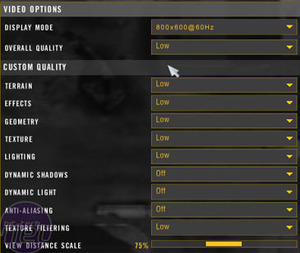
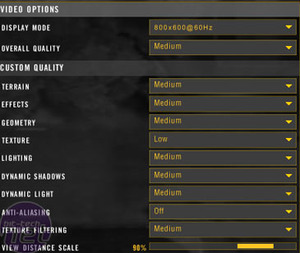

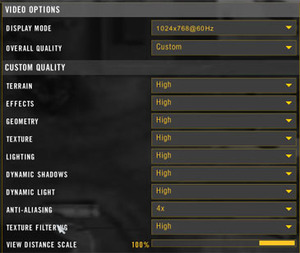 Even on high, there are some features turned down or off. This is because the Battlefield 2 engine is extremely intensive - indeed, it seems to need more oomph than even Half-Life 2. This is because of the huge outdoor maps it's rendering. The last image is what I've called 'Ultra' quality - everything set to full at 1024.
Even on high, there are some features turned down or off. This is because the Battlefield 2 engine is extremely intensive - indeed, it seems to need more oomph than even Half-Life 2. This is because of the huge outdoor maps it's rendering. The last image is what I've called 'Ultra' quality - everything set to full at 1024.
At High Quality, you get maximum texture resolution, anisotropic filtering on textures, dynamic lighting, dynamic shadows and self-shadowing, as well as better-looking vegetation and terrain and a longer view distance.
Medium quality, you won't be surprised to hear, is a fairly healthy compromise between these two.

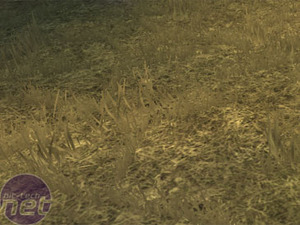 You can see the quite horrendous quality of the grass at Low Quality, and the extra detail added at High Quality.
You can see the quite horrendous quality of the grass at Low Quality, and the extra detail added at High Quality.
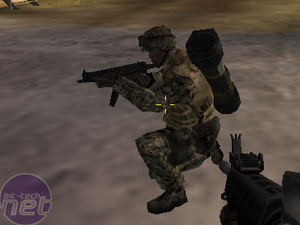
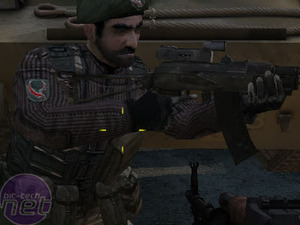 On the left, you can see the suit on the soldier has less detail than on the right, which is the High Quality version. The gun is also less detailed.
On the left, you can see the suit on the soldier has less detail than on the right, which is the High Quality version. The gun is also less detailed.
Worth noting is that the high quality preset is 1024 resolution, but with no anti-aliasing. This can look pretty horrendous on anything larger than a 17" monitor, as you'll see when we look at anti-aliasing on the next page.
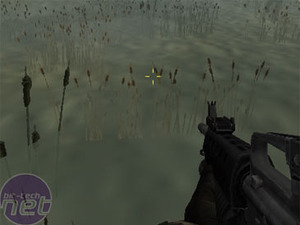
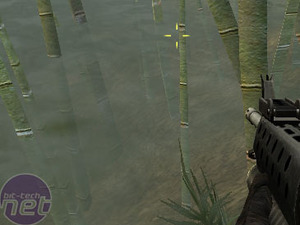 We have to admit, we think the water effects are rather poor - even on high, there's a lack of depth and reflections that makes this engine look a little primitive, especially when compared to some of the outrageous eye-candy of Guild Wars.
We have to admit, we think the water effects are rather poor - even on high, there's a lack of depth and reflections that makes this engine look a little primitive, especially when compared to some of the outrageous eye-candy of Guild Wars.
Battlefield 2 is written for DirectX 9, featuring such graphical goodies as normal mapping, per-pixel lighting, sun bloom, and various post-processing effects. If your graphics card uses Shader Model 2.0 or higher, you'll be laughing; the rendered output is designed to be identical on both ATI and NVIDIA cards, although some hardware features may result in a performance increase.
The minimum requirement is a Shader 1.4 card with at least 128MB of memory: ATI gamers will need a Radeon 8500 or higher, and NVIDIA fans will need a GeForce 5700 or above - a GeForce 4 Ti won't do Shader 1.4 unfortunately. If you ever needed an excuse to upgrade, this game could be it.
We talked to Digital Illusions CE, the developer of the game, and where appropriate, their comments have been included in our look at the game engine.
Graphics options
There are a plethora of graphics options that you can tweak in-game: DICE have kindly included Low, Medium and High Quality profiles that contain some presets. Here are some screenshots highlighting what features are enabled for each preset:



In-game quality
At Low Quality, texture resolution is scaled down to 1/16th of the original texture in some cases. The filtering is only bi-linear, and there's no bump mapping or dynamic lighting. You can forget about shadows too! There's also severe cutbacks on vegetation and terrain detail.At High Quality, you get maximum texture resolution, anisotropic filtering on textures, dynamic lighting, dynamic shadows and self-shadowing, as well as better-looking vegetation and terrain and a longer view distance.
Medium quality, you won't be surprised to hear, is a fairly healthy compromise between these two.




Worth noting is that the high quality preset is 1024 resolution, but with no anti-aliasing. This can look pretty horrendous on anything larger than a 17" monitor, as you'll see when we look at anti-aliasing on the next page.



MSI MPG Velox 100R Chassis Review
October 14 2021 | 15:04










Want to comment? Please log in.